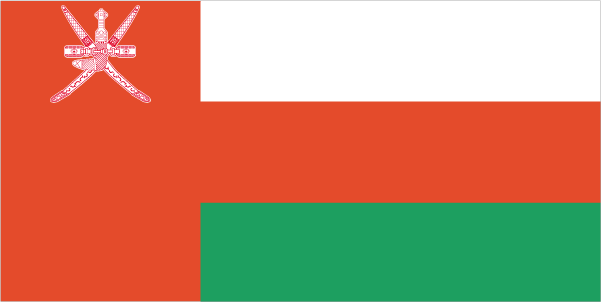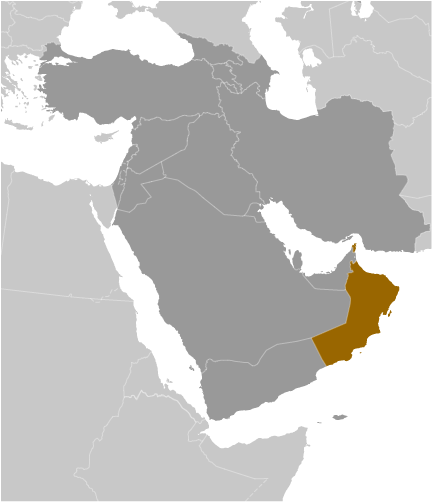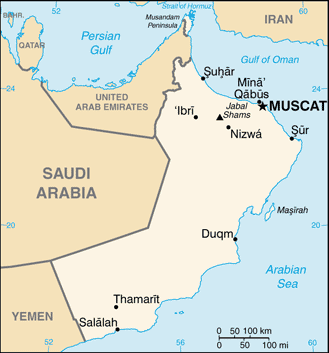
|
|
Advertisements:
GovernmentCountry name
Conventional long form Sultanate of Oman
Conventional short form Oman Local long form Saltanat Uman Local short form Uman Former Muscat and Oman Government type
Monarchy
Capital
Name Muscat
Geographic coordinates 23 37 N, 58 35 E Time difference UTC+4 (9 hours ahead of Washington, DC during Standard Time) Administrative divisions
11 governorates (muhafazat, singular - muhafazat); Ad Dakhiliyah, Al Buraymi, Al Wusta, Az Zahirah, Janub al Batinah (Al Batinah South), Janub ash Sharqiyah (Ash Sharqiyah South), Masqat (Muscat), Musandam, Shamal al Batinah (Al Batinah North), Shamal ash Sharqiyah (Ash Sharqiyah North), Zufar (Dhofar) Independence
1650 (expulsion of the Portuguese) Constitution
None; note - on 6 November 1996, Sultan QABOOS issued a royal decree promulgating a basic law considered by the government to be a constitution which, among other things, clarifies the royal succession, provides for a prime minister, bars ministers from holding interests in companies doing business with the government, establishes a bicameral legislature, and guarantees basic civil liberties for Omani citizens Legal system
Mixed legal system of Anglo-Saxon law and Islamic law International law organization participation
Has not submitted an ICJ jurisdiction declaration; non-party state to the ICCt Suffrage
21 years of age; universal; note - members of the military and security forces by law are not allowed to vote Executive branch
Chief of state
Sultan and Prime Minister QABOOS bin Said Al-Said (sultan since 23 July 1970 and prime minister since 23 July 1972); note - the monarch is both the chief of state and head of government Head of government Sultan and Prime Minister QABOOS bin Said Al-Said (sultan since 23 July 1970 and prime minister since 23 July 1972) Cabinet Cabinet appointed by the monarch Elections The Ruling Family Council determines a successor from the Sultan's extended family; if the Council cannot form a consensus within three days of the Sultan's death or incapacitation, the Defense Council will relay a predetermined heir as chosen by the Sultan Legislative branch
Bicameral Council of Oman or Majlis Oman consists of Majlis al-Dawla or upper chamber (71 seats; members appointed by the monarch; has only advisory powers) and Majlis al-Shura or lower chamber (84 seats; members elected by popular vote to serve four-year terms; body has authority to draft legislation but is subordinate to the Sultan) Elections Last held on 15 October 2011 (next to be held in October 2015) Election results Percent of vote by party - NA; seats by party - NA; note - three prominent figures from the spring 2011 protests won seats; one woman also won a seat Judicial branch
Supreme Court
Note The nascent civil court system, administered by region, has judges who practice secular and sharia law Political parties and leaders
Political parties are illegal
Political pressure groups and leaders
None
International organization participation
ABEDA, AFESD, AMF, FAO, G-77, GCC, IAEA, IBRD, ICAO, IDA, IDB, IFAD, IFC, IHO, ILO, IMF, IMO, IMSO, Interpol, IOC, IPU, ISO, ITSO, ITU, LAS, MIGA, NAM, OIC, OPCW, UN, UNCTAD, UNESCO, UNIDO, UNWTO, UPU, WCO, WFTU, WHO, WIPO, WMO, WTO Diplomatic representation in the us
Chief of mission
Ambassador Hunaina bint Sultan bin Ahmad al-MUGHAIRI Chancery 2535 Belmont Road, NW, Washington, DC 20008 Telephone [1] (202) 387-1980FAX [1] (202) 745-4933 Diplomatic representation from the us
Chief of mission
Ambassador (vacant); Charge d'Affaires W. Johann SCHMONSEES Embassy Jameat A'Duwal Al Arabiya Street, Al Khuwair area, Muscat Mailing address P. O. Box 202, P.C. 115, Madinat Sultan Qaboos, Muscat Telephone [968] 24-643-400FAX [968] 24-699771 Flag description
Three horizontal bands of white, red, and green of equal width with a broad, vertical, red band on the hoist side; the national emblem (a khanjar dagger in its sheath superimposed on two crossed swords in scabbards) in white is centered near the top of the vertical band; white represents peace and prosperity, red recalls battles against foreign invaders, and green symbolizes the Jebel Akhdar (Green Mountains) and fertility National symbol(s)
Khanjar dagger superimposed on two crossed swords National anthem
Name
"Nashid as-Salaam as-Sultani" (The Sultan's Anthem) Lyrics/music Rashid bin Uzayyiz al KHUSAIDI/James Frederick MILLS, arranged by Bernard EBBINGHAUS Note Adopted 1932; new words were written after QABOOS bin Said al Said gained power in 1970; the anthem was first performed by the band of a British ship as a salute to the Sultan during a 1932 visit to Muscat; the bandmaster of the HMS Hawkins was asked to write a salutation to the Sultan on the occasion of his visiting the ship
Comments
Add a new comment: |
Advertisement
Members area
Oman (Muscat):
 
GPS points from Oman (Muscat)
|
||||||||

 The inhabitants of the area of Oman have long prospered on Indian Ocean trade. In the late 18th century, a newly established sultanate in Muscat signed the first in a series of friendship treaties with Britain. Over time, Oman's dependence on British political and military advisors increased, but it never became a British colony. In 1970, QABOOS bin Said Al-Said overthrew the restrictive rule of his father; he has ruled as sultan ever since. His extensive modernization program has opened the country to the outside world while preserving the longstanding close ties with the UK. Oman's moderate, independent foreign policy has sought to maintain good relations with all Middle Eastern countries. Inspired by the popular uprisings that swept the Middle East and North Africa in 2010-11, Omanis began staging marches and demonstrations to demand economic benefits, an end to corruption, and greater political rights. In February and March 2011, in response to protester demands, QABOOS pledged to create more government jobs and promised to implement economic and political reforms, such as granting legislative and regulatory powers to the Council of Oman and the introduction of unemployment benefits. Also in March, the Gulf Cooperation Council pledged $20 billion in financial aid to Oman and Bahrain over a 10-year period to assist the two nations in their struggle with Arab protests. Amid concessions made to oppositionists, the government during the summer continued to crack down on protests and demonstrations, and increasingly clamped down on the media. In October 2011, QABOOS issued a royal decree expanding the legislative powers of the Council of Oman to draft, amend, and approve legislation.
The inhabitants of the area of Oman have long prospered on Indian Ocean trade. In the late 18th century, a newly established sultanate in Muscat signed the first in a series of friendship treaties with Britain. Over time, Oman's dependence on British political and military advisors increased, but it never became a British colony. In 1970, QABOOS bin Said Al-Said overthrew the restrictive rule of his father; he has ruled as sultan ever since. His extensive modernization program has opened the country to the outside world while preserving the longstanding close ties with the UK. Oman's moderate, independent foreign policy has sought to maintain good relations with all Middle Eastern countries. Inspired by the popular uprisings that swept the Middle East and North Africa in 2010-11, Omanis began staging marches and demonstrations to demand economic benefits, an end to corruption, and greater political rights. In February and March 2011, in response to protester demands, QABOOS pledged to create more government jobs and promised to implement economic and political reforms, such as granting legislative and regulatory powers to the Council of Oman and the introduction of unemployment benefits. Also in March, the Gulf Cooperation Council pledged $20 billion in financial aid to Oman and Bahrain over a 10-year period to assist the two nations in their struggle with Arab protests. Amid concessions made to oppositionists, the government during the summer continued to crack down on protests and demonstrations, and increasingly clamped down on the media. In October 2011, QABOOS issued a royal decree expanding the legislative powers of the Council of Oman to draft, amend, and approve legislation. 